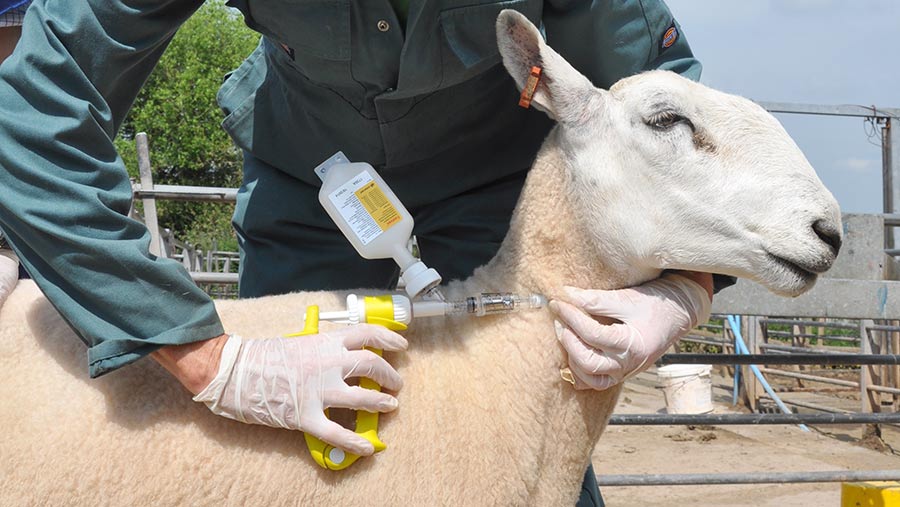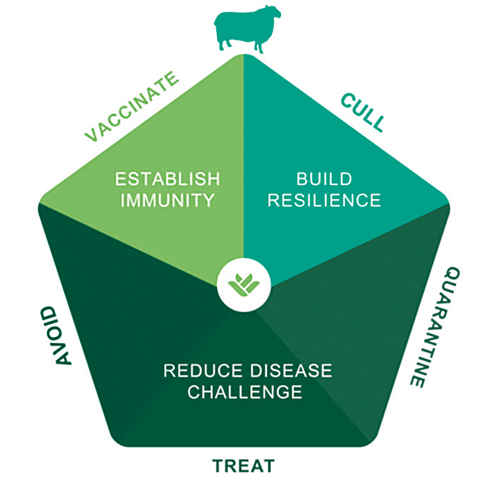Advice on how to vaccinate sheep against foot-rot
 Katie Hovers demonstrating correct vaccination procedure
Katie Hovers demonstrating correct vaccination procedure Vaccination to reduce foot-rot in sheep is just one part of a national five-point plan designed to lessen overall disease pressure from infectious lameness, by improving flock resilience to the disease.
When vaccination is done in conjunction with the four other parts of the plan, the reduction in lameness levels can be dramatic. SQP Mark Pass advises on his recommendations.
See more articles on sheep lameness:
- Sheep lameness: The successes and remaining challenges
- 4 ways to reduce sheep lameness to less than 2% by 2021
- How a sheep farmer has reduced lameness by 28%
- Advice on how to vaccinate sheep against foot-rot
- Step-by-step guide to foot-bathing sheep
- Should you trim sheep’s feet to control lameness?
- Advice for quarantining incoming sheep to prevent lameness
- How sheep farmer has reduced lameness to just 3%
Watch the video of how to vaccinate properly.
Why does foot-rot need controlling?
The most common cause of lameness is foot-rot, which is an extremely painful, production-limiting disease that affects sheep of all ages.
Foot-rot is caused by the naturally occurring bacteria Dichelobacter nodosus, which is carried by healthy as well as lame sheep, and can remain infectious up to 14 days on contaminated pasture.
This means the feet of infected sheep play a significant role in the transmission of the disease.
By implementing each of the five points of the five-point plan, the incidence of sheep lameness can be reduced below 2% by the end of the third year of implementation.
How do you implement a vaccination protocol?
Vaccination is an aid to preventing lameness by stimulating immunity to the bacteria causing foot-rot. Vaccination should be on a whole-flock basis and timed to coincide with times of high disease risk on the farm.
When is the best time to vaccinate?
The important thing about vaccination is fitting it into the farming calendar. The timings you need to consider include:
- Make sure you leave six weeks between the first dose and the booster.
- Make sure no other vaccines are used within two weeks of vaccination, to allow the immune system to fully respond to one vaccine before using another.
- When vaccinating close to tupping or lambing, make sure you vaccinate at least six weeks before tupping, four weeks before lambing or four weeks after lambing, to prevent the immune response affecting fertility and to avoid stress at these critical times.
- Don’t vaccinate six to eight weeks before shearing, and within the previous six months of animals being shown or sold, as a well-
defined, inactive lump at the site of injection may occur.
Most people will vaccinate before the risk period on their farm, and that time will obviously differ between farms.
For some, foot-rot may be more of a spring/summer issue after lambing, but for others it could be in the autumn or when animals are housed. Timing should be four weeks before the risk period.
You need to work with your healthcare provider to see when the problem is, and then plan in the vaccination, tailored to meet the individual flock.
FAI Five-Point Plan

Does the vaccine cause lumps?
Yes. The vaccine may cause a sterile lump at the site of injection. This may range from a slight swelling from about 24 hours after injection, to a well-defined lump of about 3cm diameter eight days after injection.
These may further increase in size to 5cm or even 8cm diameter, but these swellings generally remain inactive and may resolve completely within four to six weeks. But some swellings may last for at least 10 weeks.
How often do you need to vaccinate?
Initial course: Two doses should be given six weeks apart. Depending how bad the foot-rot situation is on your farm, after the second booster, you can move to twice-yearly doses.
However, a single annual booster may be enough once lameness due to foot-rot has been successfully reduced to a very low incidence, or where there is one clear annual risk period.
How do you inject the vaccine?
A dose of 1ml should be injected under the skin, on the side of the neck, two to three inches below the ear.
It is important to inject under the skin and not into the muscle. Ideally, you should also use a Sterimatic needle/applicator system (subcutaneous vaccination pack) to minimise any bacterial contamination which can cause abscesses.
Are there any potential reactions with other treatments that might be used?
When treating sheep previously vaccinated with Footvax with endoparasiticide injections, ensure you refer to the respective product contraindications prior to use. Some sheep can develop a sensitivity. This is uncommon, but can be fatal.
What age must sheep be before you vaccinate them?
There is normally not a requirement to vaccinate lambs as they are not on the farm long enough.
They usually only suffer scald during this time, and because this is caused by the same bacteria as foot-rot, lameness control in the adult flock will have benefits in the youngstock.
Can you use the vaccine in cold weather?
Yes. The vaccine contains an oil adjuvant, so in cold weather you should warm it up by immersing in warm water for three to four minutes or warm it in your hands or back trouser pocket.
Any special precautions I should take when using this vaccine?
It is important to make sure your handling systems are adequate, and sheep can be secured when administering the vaccine.
Extra care should be taken when using this product, as it contains mineral oil. Should you accidentally inject yourself, even only a small amount, it is vital you seek medical advice and take the package leaflet with you.
Accidental injection/self-injection may result in severe pain and swelling, particularly if injected into a joint or finger. In rare cases, this could result in the loss of the affected finger if prompt medical attention is not given.
Sponsor’s message

Through July and into August, MSD Animal Health, together with Farmers Weekly, will be highlighting how the FAI Five-Point Plan (5PP) gives sheep farmers a clear framework for managing lameness effectively. We will bring together recommendations from key stakeholders in the sheep farming community to provide best practice guidance and a range of practical tips.
Adoption of the 5PP will maintain progress towards the industry target of achieving less than 2% lameness (as per FAWC 2011) in the national flock by 2021. Widespread adoption of the 5PP will also help reduce the amount of antibiotics used by the sheep industry by at least 10%, in line with the RUMA Targets Task Force 2017 recommendations.
For a healthy view of a sound flock, follow the Five-Point Plan:
- Cull – to build flock resilience
- Treat, Quarantine and Avoid – to reduce the disease challenge
- Vaccinate – to establish immunity
Further detailed advice and support is available from vet practices and SQPs in animal health trade outlets.
Thanks to MSD Animal Health, whose sponsorship made it possible to run the Sheep Lameness Roundtable 2019. Farmers Weekly had complete editorial control of this report.
